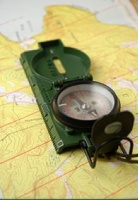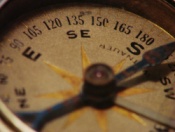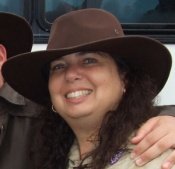 |
||||
Learning How To Read A Compass, Some Basics of Compass LearningOne of the tools that explorers of yesteryear relied on in their travels was the compass. Learning how to read a compass is still a valuable skill used today in navigation and in recreation to help people determine in which direction they are headed. While the compass alone has only limited use in long range navigation, it can be quite useful and entertaining without other tools in a smaller area such as a park or campground. In order to learn how to read a compass, first we must look at some of the basics of the compass. How does a compass work? It is a simple device that uses a magnetic needle or card balanced on a pivot point in such a way that it should sit perfectly level and with as little friction as possible with the base. The card or needle will indicate which way magnetic north is. It is important to note that the compass is pointing in the same direction that the earths magnetic fields line up, not toward the north end of the earths axis. This will only be important if you are using a compass with a map or to set up other equipment that requires knowing True North. The only other technical note we will caution you about with compass reading is that the balance of the card or needle is different for different regions of the planet. This is only a concern if you plan to travel from one continent to another.  There are two other styles of compasses that include extra features to make them better suited for their specific tasks. Compasses with orienteering base plates and lensatic compasses. The orienteering base plates are designed to work with topographical maps. The lensatic compass has a sighting device that allows you to take a much more precise compass bearing. You will only need to invest in these compasses if you intend to engage in the more challenging sports or you are using the compass as one of your primary navigational tools. In order to learn how to read a compass you must understand the markings that are on the face of the compass. Let's take a look at the face of the compass. Be careful you are not using a compass where it will be affected by iron, steel, or electrical equipment. This can include any watches, knives, or other tools on your person that are close to the compass and man-made structures such as concrete which has steel reinforcement, buildings, and bridges.
Subscribe To Our Newsletter
|
||||
- Our subscribers learn fun camping activities to do when camping...for both kids and adults.
- Our subscribers learn easy creative delicious meals to make when camping...Break out of the same old camping meal rut.
- Our subscribers discover great new places to camp and explore from coast to coast.
Now to get your compass reading, hold the compass in the palm of your hand and against your chest so that it is sitting level. Stand in a relaxed, comfortable position, facing the direction for which you wish to find your compass bearing. Look down at the compass and slowly turn the compass until the needle or card points to the N or 360 mark on the base or ring of the compass. Finally, read the number that is directly across from you and pointing toward the direction you want to find the compass bearing.

Here are some easy camping activities to use when family camping that are perfect for teaching your kids how to read a compass. The best way they will learn how to use a compass is by actualy using a compass! When we are out with our scouts we teach compass orienteering by setting up a simple compass course, giving each adult or child a compass and having them follow it. One person places a small object or marker and then the others locate it based on a set of directions that include compass bearings and distances to travel.
To measure distances, everyone should walk a set path where they will each count the number of paces. Typically a 100' or 30m distance will work well. With simple math, they will then be able to translate their paces into foot or meter measurements.
Start by selecting a starting point, a stationary landmark such as a picnic table, fire pit, dining fly, etc. Now, using a compass, take a compass bearing in the direction you wish to head in. Count the paces to a point, convert the paces into feet or meters, mark that down, then change direction and take the new compass bearing, counting the paces to measure to the next point. Repeat the process as many times as you like, marking down each segment of the course. Keep in mind that each segment you add, or turn, will make the course more challenging for those following it, so keep in mind the age of the persons you are trying to teach how to read a compass. The person who stops closest to the marker you placed is the winner.
Return To Your-Camping-Guidebook.com Home Page
from How To Read A Compass
[?] Keep up with the latest additions to this site as they are added by subscribing to this site's RSS Feed






Burning Issues
Ask Camping Jewel
- Have A Question?
- Need Some Advice?

Can't Find It?
Search This Site:

Copyright©
2007-2009. Your-Camping-Guidebook.com